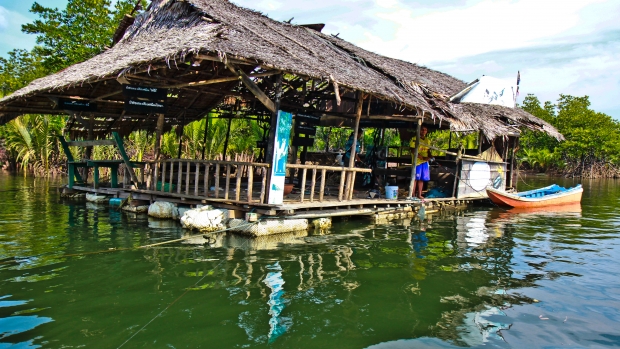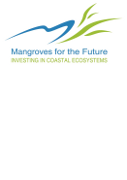Grants :: Small Grant Facilities :: Planning Sustainable Use of Mangrove
Planning Sustainable Use of Mangrove

Floating class room in Ka Poe estuary, Kapoe, Ranong, Thailand © Siriporn Sriaram, 2012
Objectives
1. To build community mangrove nursery for maintaining biodiversity and community livelihoods
2. To restore degraded mangrove areas in project location
3. To increase long-term conservation awareness among community members in project location
Background
Mangrove Restoration Group of Tambon Kapoe: Established in 2005 following the Tsunami, by core community leaders of Baan (village) Chi Mi, Baan Darn and Baan Banglamphu , with objective to assist the victims and rehabilitate mangrove. The network has continuously been launching conservation activities with financial supports from several agencies, such as, UNDP, IUCN, and MFF SGF phase-I. The group is now a member of Kapoe Bay Conservation Network which launch ecosystems protection “from-ridge-to-reef”, and of Andaman Coastal Community Network. In 2008, the group was awarded “Outstanding Conservation of Mangrove” from the Department of Marine and Coastal Resources.
Target beneficiaries
130 out of 528 households who earn their living through fishery and depend upon provisions of mangrove for livelihood activities. The per capita income is THB 51,600.
Outputs
Expected outputs
|
Main Activities (กิจกรรม) |
Main Anticipated Result (ผลที่คาดว่าจะได้รับ) |
|
1. Upgrading the existing nursery to better serve project activities, such as access road, fencing and labeling the species (กิจกรรม 1) 2. Launching nursery activities, such as collection of seasonal species, procurement of raw materials including maintenance(กิจกรรม 2) 3. Preparing selected degraded area for reforestation followed by reforestation (กิจกรรม 3) 4. Launching campaigns to build conservation awareness of youth groups on special occasions and by other dissemination facilities (existing floating learning centre and publication) (กิจกรรม 4)
|
1. Emergence of a nursery of 30 M X 40 M continuously producing at least 15 mangrove species of at least 30,000 seedlings / year 2. Degraded mangrove area of 8 ha being rehabilitated and maintained properly 3. The existing floating learning centre being upgraded and better serving environment education activities 4. Evinced increased capacity & awareness of targeted population (200 persons/organized event) Note: At least 100 women would benefit from the project. This includes marginal population in several villages in project location. As to youth group, students from 2 community schools would benefit in term of education through activity participation, since some facilities of the project are incorporate in local curriculum. |
Accomplishments and challenges
Accomplishments
- Increased conservation awareness of targeted communities prompted collective measures against illegal fishing which had considerably threatened young aquatic animals and its habitats.
- Increased harmonization and better participation in community activities among community members were evinced after launching the project.
- Since one area of mangrove had been restored and used as a crab habitat, this area was found richer in crabs , increasing the catch from 10 kg. /day to 70 kg. /day.
- There appeared to be more participatory activities from several sectors, i.e. district-chief officer, fisheries officer, Kapoe Tambol Administrative Organisation, local schools by youth council, international students, and immigration groups. It was estimated that 80% of community became more participatory.
- The community formulated a conservation and management plan with Kapoe Mangrove Development Station No. 9.
Challenges
- Natural threat such as some types of insects and animals devoured and ruined the mangrove seedlings.
- The project needed to plant mangroves’ seedlings in summer once mangroves bore fruits which was unable to be stocked until rainy season. However, since the weather in summer is not quite suitable for this activity, some amount of seedlings were dehydrated by the heat and died. The project had to re-plant lots of seedlings to replace thus keep up with proposed result.
Contributions to cross-cutting themes
Gender equality
- The project promoted women as the project implementer and beneficiaries. Thus immigrant, less privilege women groups in Baan Darn and Baan Chi Mi were able to earn their income by sewing and selling Nipa Palm leafs conserved by the project.
Lessons Learned
- The project related technical experience on mangrove planting. The experiences they acquired are summarized as follows;
- Location and soil condition should be carefully and appropriately checked for planting each species of mangrove.
- Mangrove seeds of some species, e.g. Rhizophora apiculata, Kandelia candel, need to be extremely ripe enough before planting.
- Planting seedlings in summer should be carried out more carefully so as to prevent direct heat to dehydrate the seedlings.
- Surveillance of community conserved areas to prevent illegal fishing was important activities for community and their coastal/marine resources.
- The learning centre had been playing an important role for both knowledge management, and other community-led activities.
Project Facts
Country
Location
Kapoe District, Ranong Province
Topic
Duration
19th Jun 2012 to 31st Aug 2013
MFF Grant Amount
300,000 THB
Co-financing Partner
|
From (งบจาก) |
In cash (เงินสด) |
In kind (แรงงาน สิ่งของเครื่องใช้ ที่ดิน ฯลฯ) |
|
Communities |
75,000 |
153,000 |
|
Mangrove Development Station 9 Kapoe |
- |
25,000 |
|
Total (THB) |
75,000 |
178,000 |
Implementing Partner
Mr. Wiroj Detsongpraek, Chairperson, 6/3, Moo 8 Cheemee Village, Tambon Kapoe, Kapoe District, Ranong Province, 85120
บางครั้ง นักวิทยาศาสตร์ ควรเปิดใจรับฟังภูมิปัญญาท้องถิ่น
วิโรจน์ เดชสองแพรก
The scientists, some time, may have to respect local wisdoms.
Mr. Wiroj Detsongpraek
บางครั้ง นักวิทยาศาสตร์ ควรเปิดใจรับฟังภูมิปัญญาท้องถิ่น
วิโรจน์ เดชสองแพรก
The scientists, some time, may have to respect local wisdoms.
Mr. Wiroj Detsongpraek
Related Images
Related Publications

